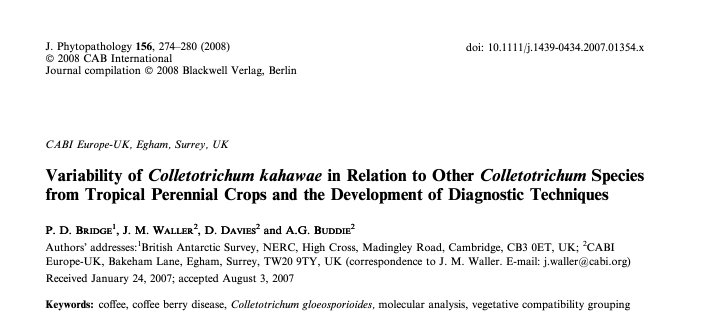Variability of Colletotrichum kahawae in Relation to Other Colletotrichum Species from Tropical Perennial Crops and the Development of Diagnostic Techniques

Twenty-six isolates of Colletotrichum kahawae, the causal agent of coffee berry disease, from coffee in Africa, and 25 isolates, mostly of Colletotrichum gloeosporioides, from coffee and other tropical perennial crops, were examined for the ability to metabolize citrate and tartrate and their molecular genetic variability was assessed using restriction fragment length polymorphisms (RFLP) and variable number tandem repeats (VNTR). Twenty-four isolates of C. kahawae were also assessed using amplified fragment length polymorphisms (AFLP). Vegetative compatibility within a collection of nine isolates, including two of C. gloeosporioides was also assessed. All isolates of C. kahawae from across Africa failed to metabolize citrate or tartrate, but all other isolates metabolized one or both. Colletotrichum kahawae isolates also showed minimal variability using the molecular techniques with two isolates from Cameroon showing slightly different banding patterns in RFLP analysis. All other isolates had variable VNTR and RFLP banding patterns. AFLP analysis failed to detect variability within 12 isolates from Kenya, but did detect differences between isolates from other countries. Five isolates from Kenya were vegetatively compatible but differed from two from Cameroon and from two C. gloeosporioides isolates. Results demonstrate some geographic variability within C. kahawae isolates, although this is small, probably due to the relatively young age of C. kahawae populations. The biochemical and molecular techniques used showed clear differences from other Colletotrichum isolates, and can be used to distinguish the species. Lack of citrate and tartrate metabolism provides a readily applicable diagnostic method.